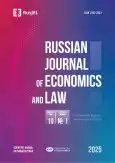The Federal rules of emojis: a proposed framework for handling emoji evidence in trial contexts
- Autores: Hurzeler M.1
-
Afiliações:
- Fordham University
- Edição: Volume 19, Nº 1 (2025)
- Páginas: 175-201
- Seção: TRANSLATED ARTICLES
- URL: https://journal-vniispk.ru/2782-2923/article/view/305074
- ID: 305074
Citar
Texto integral
Resumo
Palavras-chave
Bibliografia
- Capers, B. (2011). Crime, Legitimacy, Our Criminal Network, and the Wire. Ohio State Journal of Criminal Law, 8, 459, 466.
- Evans, V. (2017). The Emoji Code: The Linguistics Behind Smiley Faces and Scaredy Cats. Science, 357(6353), 763. https://doi.org/10.1126/science.aao5728
- Goldman, E. (2018). Emojis and the Law. Washington Law Review, 93(3), 1227–1291.
- Greenland, S. (2004). The Need for Critical Appraisal of Expert Witnesses in Epidemiology and Statistics. Wake Forest Law Review, 39, 291.
- Gross, S. R. (1991). Expert Evidence, Wisconsin Law Review, 1113, 1139.
- Hurzeler, M. (2023). The Federal Rules of Emojis: A Proposed Framework for Handling Emoji Evidence in Trial Contexts. Fordham Law Review, 92(1), 223–254.
- Janssen, E. (2018). Comment, Hearsay in the Smiley Face: Analyzing the Use of Emojis as Evidence. St. Mary’s Law Journal, 49(3), 699, 724.
- Jones, R. A., & Lidsky, L. B. (2016). Of Reasonable Readers and Unreasonable Speakers: Libel Law in a Networked World. Virginia Journal of Social Policy and the Law, 23(2), 155, 166–67.
- Kirley, E., & McMahon, M. (2018). The Emoji Factor: Humanizing the Emerging Law of Digital Speech. Tennessee Law Review, 85(2), 517.
- Kirley, E., & McMahon, M. (2019). When Cute Becomes Criminal: Emoji, Threats and Online Grooming. Minnesota Journal of Law, Science & Technology, 21(1), 37.
- Lidsky, L. B., & Norbut, L. R. (2018). #IU : Considering the context of online threats. California Law Review, 106, 1886, 1907–09.
- Milott, P. M. (2017). Emojis and Emoticons in Court. The Reporter, 44(3), 67.
- Murrie, D. C., Boccaccini, M. T., Guarnera, L. A., & Rufino, K. A. (2013). Are Forensic Experts Biased by the Side That Retained Them? Psychological Science, 24(10), 1889. https://doi.org/10.1177/0956797613481812
- Steiker, C., Kennedy, R., Taylor-Thompson, K., & Silverglate, H. (1999). Contemporary Challenges in the Criminal Justice System. New York Law School Law Review, 43, 79, 86.
- Tang, Y., & Hew, K. F. (2019). Emoticon, Emoji, and Sticker Use in Computer-Mediated Communication: A Review of Theories and Research Findings. International Journal of Communication, 13, 2457, 2468.
- Tenzer, L. Y. G., & Cangro, A. (2022). An Emoji Legal Dictionary. University of Pittsburgh Law Review, 83(5), 1. https://doi.org/10.5195/lawreview.2022.834
- Whitney, J., Jennex, M., Elkins, A., & Frost, E. (2018). Don’t Want to Get Caught?: Don’t Say It: The Use of EMOJIS in Online Human Sex Trafficking Ads. In Proceedings of the Fifty-First Hawaii International Conference on System Sciences (pp. 4273, 4275–80). https://doi.org/10.24251/hicss.2018.537
Arquivos suplementares








